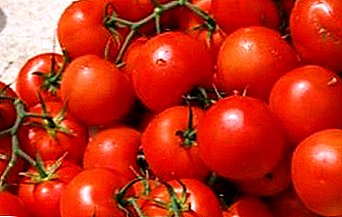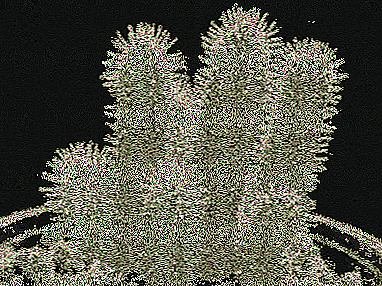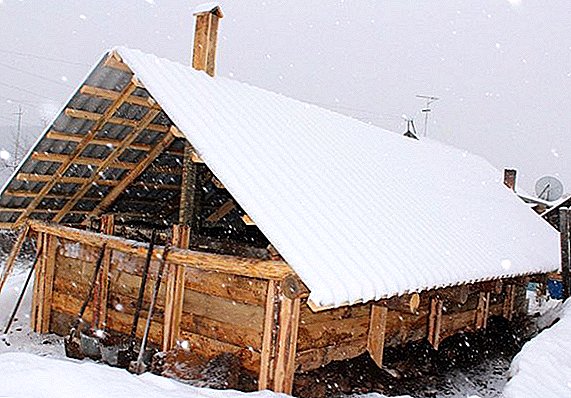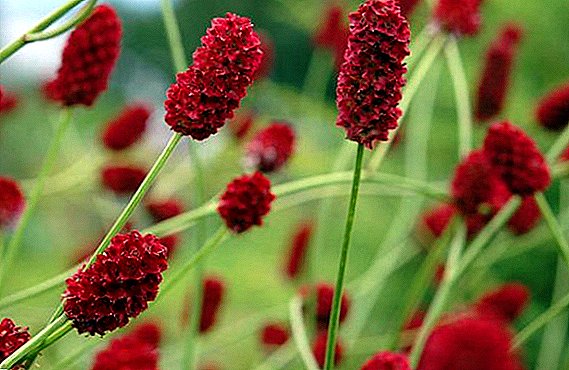
Anyone who appreciates the benefits of Verliok’s tomatoes will surely enjoy the new hybrid derived from it and called the Verliok plus f1. ”
Like its predecessor, the hybrid has a high yield, disease resistance and excellent fruit taste.
In this article you will find a complete description of this variety, you will get acquainted with its characteristics, learn to what diseases these tomatoes are susceptible, and to which they are resistant.
Tomato Verlioka Plus f1: variety description
| Grade name | Verlioka Plus F1 |
| general description | Early ripe determinant type hybrid |
| Originator | Russia |
| Ripening | 100-105 days |
| The form | Flat-rounded with weak ribbing at the stem |
| Colour | Red |
| Average tomato mass | 100-130 grams |
| Application | Universal |
| Yield varieties | up to 10 kg per square meter |
| Features of growing | The formation of a bush is necessary |
| Disease resistance | Resistant to most diseases |
 Tomato Verlioka Plus f1 is a new generation hybrid, early ripe, high-yielding. From the emergence of seedlings to the ripening of the first fruits, 100-105 days pass.
Tomato Verlioka Plus f1 is a new generation hybrid, early ripe, high-yielding. From the emergence of seedlings to the ripening of the first fruits, 100-105 days pass.
Shrubs determinative, reach 1.5 m in height. About indeterminantny grades read here. The formation of green mass is moderate, the leaves are large, dark green. Tomatoes ripen brushes of 6-10 pieces. During the fruiting period, bright red tomatoes completely cover the greens.
Fruits are large, smooth, weighing from 100 to 130 g. The shape is flat-rounded, with weak ribbing at the stem. The skin is thin, not rigid, but rather dense, well protecting the fruit from cracking. The flesh is juicy, dense, sugary on the fault. The taste is very pleasant, sweetish, not watery. The high content of sugars and dry substances allows us to recommend fruits for baby and diet food.
Compare the weight of fruit varieties with others can be in the table below:
| Grade name | Fruit weight |
| Verlioka Plus F1 | 100-130 grams |
| Miracle Lazy | 60-65 grams |
| The miracle of cinnamon | 90 grams |
| Sanka | 80-150 grams |
| Locomotive | 120-150 grams |
| Liana Pink | 80-100 grams |
| President 2 | 300 grams |
| Schelkovsky early | 40-60 grams |
| Leopold | 80-100 grams |
| Labrador | 80-150 |
Origin and Application
Hybrid "Verlioka Plus" bred by Russian breeders on the basis of the well-established variety "Verlioka". New plants have larger fruits, less sprawling bushes that do not require careful formation.
These tomatoes are ideal for greenhouses and seasonal greenhouses.. Tall bushes are recommended to tie to stakes or trellis. Harvest well stored, tomatoes can be plucked in the technical ripeness phase for ripening at home. As it has been said many times, the yield is high - up to 10 kg per square meter.
You can compare this indicator with other varieties below:
| Grade name | Yield |
| Verlioka Plus F1 | up to 10 kg per square meter |
| Katyusha | 17-20 kg per square meter |
| F1 Severenok | 3.5-4 kg from a bush |
| Aphrodite F1 | 5-6 kg from a bush |
| Aurora F1 | 13-16 kg per square meter |
| Solerosso F1 | 8 kg per square meter |
| Annie F1 | 12-13.5 kg per square meter |
| Room surprise | 2.5 kg from a bush |
| Bony m | 14-16 kg per square meter |
| F1 debut | 18-20 kg per square meter |
Tomatoes are versatile, they can be used fresh, used to make salads, appetizers, soups, side dishes, hot dishes. Tomatoes can be salted, pickled, cook pasta, mashed potatoes, mixed vegetables. Ripe fruit makes a delicious thick juice that can be consumed immediately after preparation or canned.
 Read also on our website: How to get the best crop of tomatoes in the open field? How to grow delicious tomatoes all year round in greenhouses?
Read also on our website: How to get the best crop of tomatoes in the open field? How to grow delicious tomatoes all year round in greenhouses?What varieties of tomatoes are distinguished by high yield and good immunity? What are the finer points of growing early varieties?
A photo
In the photo below you can see the variety of tomato "Verlioka Plus":



Advantages and disadvantages
Among the main advantages of the variety:
- excellent taste of ripe tomatoes;
- early amicable ripening;
- high yield;
- even, beautiful fruit suitable for sale;
- the harvest is well kept, transportation is possible;
- tomatoes tolerate temperature extremes, short-term drought;
- resistance to major diseases of the nightshade;
- undemanding agricultural practices.
There are practically no flaws in the variety. The special features include the demands on the nutritional value of the soil. High bushes need to tie up to stakes or trellis, it is recommended to pinch and pinch.
Features of growing
 Tomatoes are recommended to be grown in a seedling manner. For planting suitable seeds 2-3 years old, too old should not be used. Seed material does not need disinfection, it takes the necessary procedures before it is sold. 12 hours before planting, seeds are treated with a growth stimulator.
Tomatoes are recommended to be grown in a seedling manner. For planting suitable seeds 2-3 years old, too old should not be used. Seed material does not need disinfection, it takes the necessary procedures before it is sold. 12 hours before planting, seeds are treated with a growth stimulator.
Seeds are sown in the second half of March or early April.. The soil should be light and nutritious. The best option is a mixture of garden soil with humus or peat. The soil is calcined or spilled with a solution of copper sulfate, and then mixed with a small portion of wood ash or superphosphate.
It is most convenient to sow seeds in containers, the depth is not more than 1.5 cm. Plantings are covered with foil and placed in heat. For germination need a temperature not lower than 25 degrees. After the emergence of shoots containers are exposed to bright light, but they must be protected from direct sunlight. The temperature drops to 18-20 degrees.
When the first pair of true leaves unfolds on the seedlings, the plants swoop in separate containers. Then they need to feed the liquid complex fertilizer. Watering the seedlings should be moderate, using warm distilled water and a spray bottle.
 Read also on our website: How to prepare a spring in greenhouses? What types of soil for tomatoes exist?
Read also on our website: How to prepare a spring in greenhouses? What types of soil for tomatoes exist?What soil should be used for growing seedlings, and which for adult plants?
In the greenhouse, seedlings are moved in the second half of May. The soil is carefully loosened, wood ash is spread out in the holes (1 tbsp per plant). Tomatoes are placed at a distance of 45 cm from each other, wide inter-row spaces are needed, which can be mulched.
You need to water the plants once every 5-6 days, only warm water is used, they can drop ovaries from a cold plant. After watering, the vents in the greenhouse need to be opened, the tomatoes do not tolerate excessive moisture. In the heat of the greenhouse remains open all day. A very important point - the formation of bushes. It is preferable to pinch the main stem after the formation of the third flower brush, transferring the growth point to a strong stepson. High bushes better tie to the trellis.
During the season, tomatoes are fed 3-4 times with mineral fertilizer based on phosphorus and potassium. It can be alternated with organic matter: diluted mullein or bird droppings. A single foliar feeding is also useful with an aqueous solution of superphosphate.
As fertilizers for tomatoes are also often used: hydrogen peroxide, ammonia, ash, yeast, iodine, boric acid.
Diseases and pests
The variety of tomato "Verlioka Plus" is resistant to cladosporia, fusarium wilt, tobacco mosaic virus. Seedlings and young plants may be affected by blackleg. For prevention, the soil should be loosened often, preventing overmoistening. Frequent airing of the greenhouse, dusting the soil with wood ash will help to avoid summit or measles rot. Late blight bushes rarely affected.
If this happens, planting should be plentifully sprayed with copper-containing preparations. Fit ready-made formulations designed specifically for tomatoes. They can be replaced by homemade emulsion of water, laundry soap and copper sulfate.
You can read more about the measures of protection against it and about disease-resistant varieties in our articles.
In the greenhouse, tomatoes are threatened by aphids, naked slugs, thrips, Colorado beetles. Aphids are washed off with warm soapy water, industrial insecticides help from flying insects. They can be used only before flowering, later toxic formulations are replaced with phytopreparations.
Verlioka Tomatoes are an excellent choice for amateur gardeners or farmers. The productive early ripe hybrid is unpretentious, perfectly feels in greenhouses and greenhouses. The taste of fruits is excellent, their good commercial quality and the possibility of long-term storage make the hybrid suitable for commercial cultivation.
In the table below you will find links to tomato varieties with different ripening terms:
| Late-ripening | Middle late | Superearly |
| Grapefruit | gold fish | Alpha |
| De barao | Raspberry wonder | Pink Impreshn |
| Altaic | Market Miracle | Golden stream |
| American ribbed | De barao black | Moscow stars |
| F1 snowfall | Honey salute | Alenka |
| Podsinskoe Miracle | Krasnobay F1 | White filling |
| Long keeper | Volgogradsky 5 95 | Riddle |












